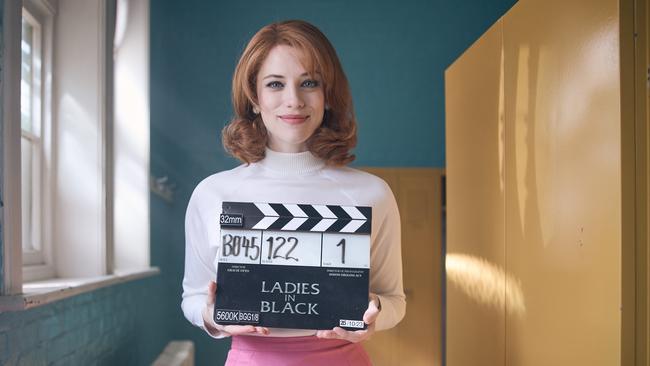Ladies in Black, inspired by Madeleine St John’s novel, is a now a clever and droll TV series
A TV series inspired by Madeleine St John’s novel takes up the thread where the hit film version left off.

Bruce Beresford’s popular movie Ladies in Black, based on Madeleine St John’s classic yet until then neglected 1993 novel The Women in Black, was a hit in 2018. It was, however, a passion project for the director that took 24 years to complete.
A university acquaintance of the Australian novelist, Beresford was alerted to the work by his friend Clive James. The director found the poignant story of a young girl – whose life is influenced by the migrant woman she meets while working in a Sydney department store called Goodes during the Christmas holidays in the late 1950s – entrancing.
“The Women in Black immediately struck me as being the work of a modern-day Jane Austen, with all the wit and acute characterisations of that great writer,” he wrote in an introduction to the novel’s reissue. Critics also had enjoyed St John’s novel when it was first released in 1993, The New York Times describing it as “a deceptively smart comic gem”.
The NYT reviewer, Susan Coll, while finding the plotlines somewhat reductive – marriage, dating and dresses – said the novel was “laced with a fierce intelligence that captures the limited options for women and post-war xenophobic views”. Kirkus Reviews found it “a quirky period fairy tale laced with female networks and glamorous gowns”, and The Guardian determined it possessed “the right combination of style and substance”.
But Beresford, having adapted the novel with his producer Sue Milliken – the title was changed, according to Milliken, because they decided The Women in Black “sounded too much like something depressing, whereas Ladies in Black’s a bit more glamorous” – found it difficult to finance. They were thwarted, he wrote, by a process he endured with the scripts of his movies Tender Mercies and Driving Miss Daisy. “Both of those projects were dismissed by various ‘readers’ – an anonymous group who supply ‘coverage’ to the finance people – as inept, pointless, amateurish, boring, etc, etc,” he wrote. “Despite these acute insights, both films would go on to win the Academy Award for Best Screenplay.”
Now St John’s novel has become a television series for the ABC and glamorous it is too, celebrating those frocks that so impressed the early critics, and the equally elegant women who sold them. It follows on from Beresford’s film and, while taking its inspiration from the novel, places the ladies from Model Gowns, where the delightful frocks still say, “Marry Me”, in fictional Goodes Department Store at the beginning of the swinging ’60s.

It’s that time of a heady, sometimes bewildering clash of sensibilities, both a smothering and sharp-edged period all at once, when safety and freedom seemed to be in opposition to one another. The 1960s, of course, remain a contested decade in cultural memory. For some it symbolises a period in which traditional standards of decency were overwhelmed by an ethic of hedonism with an emphasis on self-fulfilment and instant gratification.
For those more sympathetic, like many who lived through those years, the time witnessed a welcome challenge to the rigidity and repression of the grey-flannelled ’50s.
The series is from Bunya Entertainment, a division of Bunya Productions that has given us classics such as the Mystery Road series, based on Ivan Sen’s internationally acclaimed and award-winning feature films Mystery Road and Goldstone.
Ladies in Black takes place in 1961 and as women increasingly identify as independent, adventurous and in charge of their own sexuality, its central female characters are forced to confront life-changing choices even as they grapple with the challenges of changing aspirations. Independence comes at a cost. And for many it was the best of times and the worst of times.
The idea came from Bunya’s then co-managing director Sophia Zachariou, a producer with an enviable track record that includes shows as diverse as the Gruen series, Kitchen Cabinet with Annabel Crabb, Judith Lucy’s Spiritual Journey, and The Chaser’s Media Circus. She was looking for ideas and, an unabashed fan of Beresford’s movie, she approached the film’s producers, Milliken and Allanah Zitserman, and was able to secure the rights for the TV adaptation.
“The film was, first and foremost, a celebration of female friendship, which I loved, and I also loved the premise of it being set in a department store,” Zachariou says in the production notes. “Like the series Madmen, it’s an environment where a lot of drama can happen.
“I could see its potential for television, but I was also mindful that the film had been made some years ago and there needed to be a point of difference for new audiences.” So it was decided to move a new story into the ’60s as the sense of social change was accelerating. “The arrival of the contraceptive pill and the women’s liberation movement meant that women were trying to bust out of their shackles.”
The writing team for Ladies in Black was led by Greg Waters, who had read the novel many years ago while a script executive at the ABC. At the time he was keen to see the book adapted for television, but Beresford’s film was already under way. Direction is from the emerging Gracie Otto, who most recently worked on Disney’s The Artful Dodger, and the Stan documentary Revealed: Otto by Otto, a celebration of her actor father Barry.

There’s a terrific cast led by Debi Mazar (Entourage) as Magda Szombathelyi who dreams of her own boutique but is hampered by an unreliable husband; Jessica De Gouw (The Drover’s Wife) plays Fay Janosi, former Tivoli dancer, polished and stylish but also in an uncertain marriage; and Miranda Otto (Lord of the Rings) is the autocratic Virginia Ambrose, hired from Harrods of London to dress Sydney’s most fashionable women, those trophy wives of the eastern suburbs, but haunted by secrets from her past.
The series takes up six months after the film ends and, as well exploring this transformational time for Australian women and the problems faced by migrants, or so-called New Australians, it also dips into the world of university students. That’s where the “beatniks are offering free love and French cinema”, and where libertarian thought and a healthy distrust of authority are growing.
The first episode, Beautiful Dream, colourfully takes us into one of the pubs they frequented, along with the older libertarian group known as The Push, that “fraternity of middle-class desperates, journalists, dropout academics, gamblers and poets manques, and their doxies”, as Barry Humphries described them. It’s the place “where anyone who leaves their mark on the world drinks”, says bumptious student leader Richard White (Tom Wilson).
It all begins as the women at Model Gowns prepare for another day to the sounds of feminist anthem I Am Woman, sung in that distinctive theatrical style by Ngaiire. But, not feeling particularly empowered, the ladies who “create the best dressed women in Sydney” are having some trouble in adjusting to Mrs Ambrose – “a posh bitch with a put-on accent”, says one – who is replacing the departing Magda.
She’s hopefully leaving the gowns and frocks to set up Belle Rive, a new venture catering for “the new woman”, but soon it all comes crashing down after her husband Stephan (Russell Dykstra) lends the money destined to cover her lease to their friend Rudi (Thom Green). Her beautiful dream in tatters, she must somehow reclaim her place at Goodes.
Mrs Ambrose is everyone’s antagonist, determined to upgrade the quality of customer service into something more conservative and traditional. She’s also cunning and not above a bit of trickery to get her way.
Fay, too, has dreams, desperate for a family with new husband Rudi, but his financial risk-taking and increasing unsavouriness is making her future with him uncertain.
And Lisa (Clare Hughes), a part-timer at Goodes, has her dreams of university success and life as a writer put on hold when her father dies with no life insurance and she’s forced into full-time employment.
Not only are dreams coming undone as the story begins but Model Gowns is facing increased competition from rival Younger Brothers on Pitt Street and there’s a rather sophisticated shoplifter on the loose.
It’s all very droll and Otto and her superlative cast of clever women get the comedy of manners just right, a slightly heightened style of performance that works well.
While made with obvious affection for the women and their various dilemmas, it does lack the “unstoppable exuberance” that critics found in St John’s novel and the wit that reminded critics of Jane Austen. But there’s a simple pleasure in watching such terrific actors work the material and the period. And the frocks.
And amusingly the production gets the way that at the time there was an obvious decrease in deference in Sydney society, more openness, the way many constraints were lifting, especially when it came to talking about sexuality or expressing it in clothing and make-up. And the way it was becoming fashionable to be young.
Ladies in Black, ABC, Sundays at 8.30pm and streaming on ABC iview








To join the conversation, please log in. Don't have an account? Register
Join the conversation, you are commenting as Logout